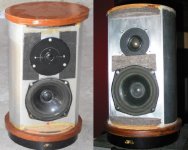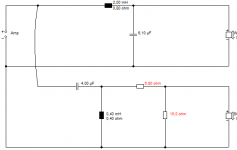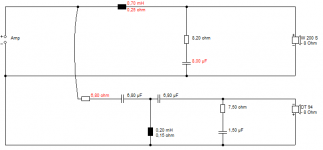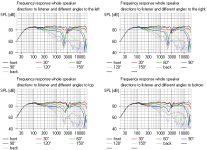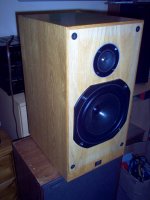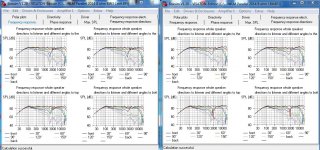Hi Folks,
A different thread got onto the topic of the JR149, a vintage speaker meant to compete with the LS3/5A.
I modified a pair and thought I'd share the outcome and design process here, attached. It was a tough design journey, the B110 being an enigma of sorts.
It was an interesting trip, and made me really appreciate the challenges faced by designers of yesteryear working with suspicious drivers and scant CAD at their disposal. It helped me respect their accomplishments that much more.
Thanks,
Dave
A different thread got onto the topic of the JR149, a vintage speaker meant to compete with the LS3/5A.
I modified a pair and thought I'd share the outcome and design process here, attached. It was a tough design journey, the B110 being an enigma of sorts.
It was an interesting trip, and made me really appreciate the challenges faced by designers of yesteryear working with suspicious drivers and scant CAD at their disposal. It helped me respect their accomplishments that much more.
Thanks,
Dave
Very nice PDF articles on fitting the JR 149 with Scanspeak D2905-9300 tweeter, Dave. Enjoyed reading that. Much simpler filter. 
There were two 5" bextrene KEF bass drivers, the original KEF B110A SP1003 used in the LS3/5A, and later smoother B110B SP1057 used in the KEF CS1. Not quite the same.
Just my OCD nature, but a schematic would have been nice. Hey, and let's lead with a picture in this thread!
I take on board your good feeling about the 4" Tang Band W4-1720 polycone for a modern equivalent:
Tang Band W4-1720 4" Underhung Midbass Driver
There were two 5" bextrene KEF bass drivers, the original KEF B110A SP1003 used in the LS3/5A, and later smoother B110B SP1057 used in the KEF CS1. Not quite the same.
Just my OCD nature, but a schematic would have been nice. Hey, and let's lead with a picture in this thread!
I take on board your good feeling about the 4" Tang Band W4-1720 polycone for a modern equivalent:
Tang Band W4-1720 4" Underhung Midbass Driver
Attachments
Thanks system7. The TS params were so off spec I couldn't tell which variant these used. 
There were also two different versions of the JR crossover, the first with a parallel trap on the woofer (LS3/5A used one as well), and the "V2" crossover which made well enough without the trap.
I tried a few iterations of a trap based crossover as well, none provides a sense of accuracy and ease I had hoped for.
Sorry about the (lack of) schematic, I knew I'd get called out for that.
Regarding the W4-1720, I very much like that driver. Very detailed for a cone not made from metal. I just updated my design spec for another small two-way, this one using the W4-1720, at
http://www.diyaudio.com/forums/mult...y-punches-above-its-weight-4.html#post4218347
Hi freddi, I've designed allot of other stuff over the years but don't generally publish. It's a miracle to find time to publish these two designs.
There were also two different versions of the JR crossover, the first with a parallel trap on the woofer (LS3/5A used one as well), and the "V2" crossover which made well enough without the trap.
I tried a few iterations of a trap based crossover as well, none provides a sense of accuracy and ease I had hoped for.
Sorry about the (lack of) schematic, I knew I'd get called out for that.
Regarding the W4-1720, I very much like that driver. Very detailed for a cone not made from metal. I just updated my design spec for another small two-way, this one using the W4-1720, at
http://www.diyaudio.com/forums/mult...y-punches-above-its-weight-4.html#post4218347
Hi freddi, I've designed allot of other stuff over the years but don't generally publish. It's a miracle to find time to publish these two designs.
I'm very equivocal about sophisticated filtering with difficult drivers. It's OK on paper, but I wonder how well it works with significant non-linearities. 
Your Napoleons look fun:
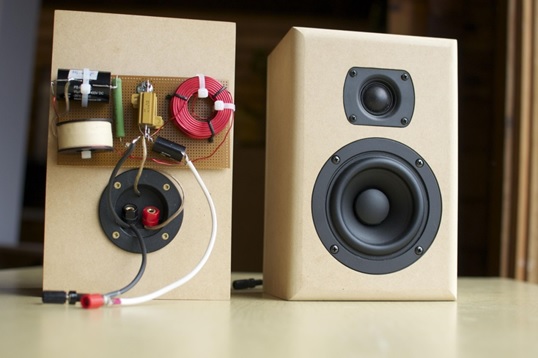
I notice I made a complete *** of myself in saying the Tang Band W4-1720 4" Underhung Midbass Driver was a polycone. It's paper.
Your idea is not unlike Eekels' Mini
If you don't mind a slight lack of bass, this is a nice idea. Certainly a great midrange for vocals.
Your Napoleons look fun:

I notice I made a complete *** of myself in saying the Tang Band W4-1720 4" Underhung Midbass Driver was a polycone. It's paper.
Your idea is not unlike Eekels' Mini
If you don't mind a slight lack of bass, this is a nice idea. Certainly a great midrange for vocals.
Last edited:
Thanks, they were fun, and the xovers were much simpler to get right than the JRs.
Mini? 4.8L, that's huuuge! Actually, they look to me to have a somewhat different application. the napoleons were made for on wall and shelf application. The Mini has that rear port and long front/back application that's not well suited for that use.
Actually, they look to me to have a somewhat different application. the napoleons were made for on wall and shelf application. The Mini has that rear port and long front/back application that's not well suited for that use.
The modest bass was a design parameter, it allows me to work in the evening at decent listening levels without someone pounding the floor above me. For daytime, a flick of the subwoofer switch takes me down to 30Hz.
They also respond very well to some gentle bass boost equalization (digital or analog) to provide some decent mid bass as that woofer can take a beating and not complain.
IME (after countless hours simming, voicing, building, testing over many years) the problem with complex crossover equalization in a standard 2 or 3 way is that its very often used to equalize at one point in space (some edge reflection or diffraction, or non-ideal driver summing) and it destroys the off axis response in an audible way. Maybe works for extreme near field or a huge room, but audible IME in a regular space. Over the years I think the sonic benefits of low order (ie simple xovers) have been mistakenly ascribed to "simpler electron path" because perhaps it wasn't understood why complex sounded bad.
Mini? 4.8L, that's huuuge!
The modest bass was a design parameter, it allows me to work in the evening at decent listening levels without someone pounding the floor above me. For daytime, a flick of the subwoofer switch takes me down to 30Hz.
They also respond very well to some gentle bass boost equalization (digital or analog) to provide some decent mid bass as that woofer can take a beating and not complain.
IME (after countless hours simming, voicing, building, testing over many years) the problem with complex crossover equalization in a standard 2 or 3 way is that its very often used to equalize at one point in space (some edge reflection or diffraction, or non-ideal driver summing) and it destroys the off axis response in an audible way. Maybe works for extreme near field or a huge room, but audible IME in a regular space. Over the years I think the sonic benefits of low order (ie simple xovers) have been mistakenly ascribed to "simpler electron path" because perhaps it wasn't understood why complex sounded bad.
You might find this article interesting then. "Audibility of different crossover types". I can hear the difference between BW3 and lean LR4. 90 degree phase BW3 works much better off-axis and no power dip. Some drivers play nicely, some don't.
http://www.ctc-dr-weber.de/speaker/Audibility%20of%20different%20crossover%20types.pdf
Ooh, I love being right! Bess 2 works well on pink noise, which is something Lynn Olson uses.
http://www.ctc-dr-weber.de/speaker/Audibility%20of%20different%20crossover%20types.pdf
This might come as a shock, but we think that the overall winner was the 3rd order Butterworth filter, which was
terribly popular in the 70's and 80's.
Ooh, I love being right! Bess 2 works well on pink noise, which is something Lynn Olson uses.
Attachments
About 20 years ago I developed a crossover topology that is my "go to" when the conditions are right. It asymptotically goes to acoustic third order but is very underdamped so through crossover it looks almost like a first order in that narrow range of overlap. Used with aligned drivers it also provides a flatter group delay than the high order Lr types.
The slow transition provides better off axis behaviour and overlap, and the third order eventual behaviour provides the power handling and low distortion.
I posted this maybe 10 yrs back on either the PE board or Madisound and George Short replied that after a few years of experimentation, he had arrived at the same topology as his favourite, and used a very similar method himself.
These are very dependent on the driver directivity and is true for a cone + dome.
My EE thesis was a new xover type with low group delay, fairly centered lobe and good power response. Analyzed mathematically via CAD (dating myself, using VAX Fortan) Small's constant voltage, a Leach modification of constant voltage which included tweeter transfer function, LR2, LR4, BE2, BE4, BES2, BES4, BW2, BW4 and in the end developed my own new alignment that just worked better. BE, BW, LR are all just all pole filters with specific Q's. My filter was all-pass derived per the LR family, but had Q somewhere between the BE and LRs (LR's are derived using BW all poles).
Thanks for the paper on audibility. His finding's makes sense. In a BW3, at the observation point the acoustic responses of each driver are 90 deg out of phase but sum flat. That means that a different vertical angle somewhere, they'll be in phase and sum to a +3 dB bump. The LR types show no such off axis bump, as they're in phase at the listening axis and can only be more out of phase at any other vertical angle (ie sum to a dip). They heard this as less energy for the LR. The BW's dump more energy into the room through crossover, all else being equal. This can also help correct for a driver's narrowing dispersion off axis: the better phase matching off axis can be made to correct for a driver's narrowing dispersion. Without knowing it, I think its one reason designers tend to push the LR xovers as low as possible, minimizing the double wammy of narrowing dispersion and off axis cancellation.
It's all a balancing act, and I think the authors may have found different results with a tweeter instead of two cones at 800 Hz. A BW3 for example would help fill in for a typical 6.5" woofer' narrowing dispersion off axis but then the tweeter kicks in and adds too much energy right around 3 to 5 kHz.
It also depends on the room and I touch a bit on that in my paper. In a large or overly damped room, I lend much more precedent to on axis flatness (LRs make more sense in that application). The smaller and livelier the room, and the more the off axis responses affect perceived tonal balance and the more the other types start to shine.
It's all just cookin' in the end, those are some of my basic recipes after many years of experimentation and trial and error. I hope someone tries these and gets a kick out of it.
Where's a Bryan Cranston T Shirt when I need it?
The slow transition provides better off axis behaviour and overlap, and the third order eventual behaviour provides the power handling and low distortion.
I posted this maybe 10 yrs back on either the PE board or Madisound and George Short replied that after a few years of experimentation, he had arrived at the same topology as his favourite, and used a very similar method himself.
These are very dependent on the driver directivity and is true for a cone + dome.
My EE thesis was a new xover type with low group delay, fairly centered lobe and good power response. Analyzed mathematically via CAD (dating myself, using VAX Fortan) Small's constant voltage, a Leach modification of constant voltage which included tweeter transfer function, LR2, LR4, BE2, BE4, BES2, BES4, BW2, BW4 and in the end developed my own new alignment that just worked better. BE, BW, LR are all just all pole filters with specific Q's. My filter was all-pass derived per the LR family, but had Q somewhere between the BE and LRs (LR's are derived using BW all poles).
Thanks for the paper on audibility. His finding's makes sense. In a BW3, at the observation point the acoustic responses of each driver are 90 deg out of phase but sum flat. That means that a different vertical angle somewhere, they'll be in phase and sum to a +3 dB bump. The LR types show no such off axis bump, as they're in phase at the listening axis and can only be more out of phase at any other vertical angle (ie sum to a dip). They heard this as less energy for the LR. The BW's dump more energy into the room through crossover, all else being equal. This can also help correct for a driver's narrowing dispersion off axis: the better phase matching off axis can be made to correct for a driver's narrowing dispersion. Without knowing it, I think its one reason designers tend to push the LR xovers as low as possible, minimizing the double wammy of narrowing dispersion and off axis cancellation.
It's all a balancing act, and I think the authors may have found different results with a tweeter instead of two cones at 800 Hz. A BW3 for example would help fill in for a typical 6.5" woofer' narrowing dispersion off axis but then the tweeter kicks in and adds too much energy right around 3 to 5 kHz.
It also depends on the room and I touch a bit on that in my paper. In a large or overly damped room, I lend much more precedent to on axis flatness (LRs make more sense in that application). The smaller and livelier the room, and the more the off axis responses affect perceived tonal balance and the more the other types start to shine.
It's all just cookin' in the end, those are some of my basic recipes after many years of experimentation and trial and error. I hope someone tries these and gets a kick out of it.
Where's a Bryan Cranston T Shirt when I need it?
Last edited:
You sound like someone who TRIES things too! 
I got some flak recently for saying BW3 was worth a go. The criticism was that since LR4 is 90% of published designs, it must be the best/winner...
Troels Gravesen always has interesting observations.
ATS-4
He's currently interested in dynamics in a speaker. Talk of paper voicecoil formers, high Qms and such. LR2 lends itself naturally to 3 ways. Troels observed that LR2 seems to need some BBC dip on the tweeter, more than LR4. It makes sense, and I found this with 6" bass and tweeter which never has steep rolloff. You've got a wider power dip with LR2 in the middle, and that makes the very top sound overly bright.
I still have fun with those old cone tweeters. Rather musical IMO. Here's the BW3 versus LR4 graph I should have posted originally. Look, no null above and below axis!
I got some flak recently for saying BW3 was worth a go. The criticism was that since LR4 is 90% of published designs, it must be the best/winner...
Troels Gravesen always has interesting observations.
ATS-4
He's currently interested in dynamics in a speaker. Talk of paper voicecoil formers, high Qms and such. LR2 lends itself naturally to 3 ways. Troels observed that LR2 seems to need some BBC dip on the tweeter, more than LR4. It makes sense, and I found this with 6" bass and tweeter which never has steep rolloff. You've got a wider power dip with LR2 in the middle, and that makes the very top sound overly bright.
I still have fun with those old cone tweeters. Rather musical IMO. Here's the BW3 versus LR4 graph I should have posted originally. Look, no null above and below axis!
Attachments
That's a heck of a good response you're getting out of that cone tweeter. Do you find they have such good dispersion as a rule or is this one a ringer?
I experiment (well, used to before the kids) like crazy, a great way to learn. The irony is by the time I have spare time to devote to this again (retire), my ears will be shot.
No flak from me, I totally get why a BW3 can sound better! Do you add some extra distance between the high and low pass frequencies to get it so flat? That works gangbusters IME. Get the good on axis and less of the weird upper woofer suck out of an LR type.
I experiment (well, used to before the kids) like crazy, a great way to learn. The irony is by the time I have spare time to devote to this again (retire), my ears will be shot.
No flak from me, I totally get why a BW3 can sound better! Do you add some extra distance between the high and low pass frequencies to get it so flat? That works gangbusters IME. Get the good on axis and less of the weird upper woofer suck out of an LR type.
Ooh, whoops. I mislead you there. The dispersion is more with a Visaton DT-94 1" mylar tweeter IIRC. A cone isn't so wide at high frequency. This one I think:
8" bass and tweeter just happens to align nicely on phase if you wire the tweeter negative polarity on BW3. Which maybe why KEF and the BBC had such good fortune with it. One of my interests is what makes a tweeter sound good. I'd consider a cone, metal dome or an XT25 type ring radiator amongst the good common devices. Soft-domes just don't work above 7kHz IMO.
You made some interesting remarks about bass that upsets the neighbours. I try to keep it minimal, lean and closed box myself. When you listen to car stereos outside the vehicle, all you often hear is the thumping bass. I think something similar happens with bassy domestic speakers. Hence the bangs on the ceiling!
An externally hosted image should be here but it was not working when we last tested it.
8" bass and tweeter just happens to align nicely on phase if you wire the tweeter negative polarity on BW3. Which maybe why KEF and the BBC had such good fortune with it. One of my interests is what makes a tweeter sound good. I'd consider a cone, metal dome or an XT25 type ring radiator amongst the good common devices. Soft-domes just don't work above 7kHz IMO.
You made some interesting remarks about bass that upsets the neighbours. I try to keep it minimal, lean and closed box myself. When you listen to car stereos outside the vehicle, all you often hear is the thumping bass. I think something similar happens with bassy domestic speakers. Hence the bangs on the ceiling!
Last edited:
- Status
- This old topic is closed. If you want to reopen this topic, contact a moderator using the "Report Post" button.
- Home
- Loudspeakers
- Multi-Way
- JR149 Redesign
